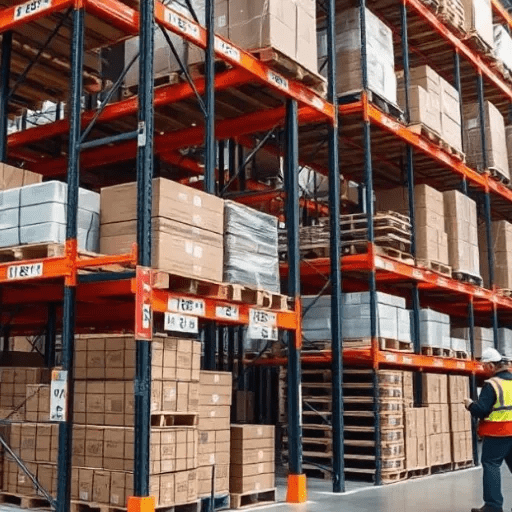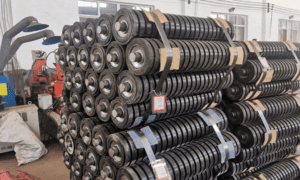The global supply chain depends on the humble pallet. These flat transport structures support goods as they move from warehouses to trucks, ships, and storefronts. While traditionally made of wood, a new generation of reinforced plastic pallets is changing the game. By incorporating materials such as steel and fiberglass, these advanced pallets offer unprecedented strength and durability, transforming how businesses handle their products. This guide will explore the technology behind reinforced pallets. We’ll examine the materials used, their impact on load-bearing capacity, and the industries that benefit most from their adoption. From enhancing shipping efficiency to improving workplace safety, reinforced pallets represent a significant step forward in logistics and material handling. Click here to read more
Introduction to Reinforced Pallet Technology
What is a Reinforced Plastic Pallet?
A reinforced plastic pallet is a high-performance platform engineered for superior strength and durability. Unlike standard plastic pallets, which are molded from a single material, reinforced pallets incorporate additional structural elements, typically steel or fiberglass rods. These rods are strategically placed within the pallet’s structure during the manufacturing process.
The purpose of this reinforcement is to dramatically increase the pallet’s ability to withstand heavy loads and resist bending or breaking, especially in demanding racking and stacking applications. This makes them a reliable and long-lasting alternative to traditional wood or standard plastic pallets.
Benefits of Using Reinforced Pallets
Integrating reinforced pallets into a supply chain offers substantial advantages over conventional options.
- Enhanced Durability: The core benefit is their extended lifespan. Reinforcement makes them highly resistant to impacts and the stress of heavy, repeated use. This means fewer replacements and lower long-term costs.
- Superior Load Capacity: They can handle significantly heavier loads than their non-reinforced counterparts. This is critical for industries dealing with dense or bulky goods, as it ensures stability and safety during transport and storage.
- Improved Safety: The risk of pallet failure under load is drastically reduced. This prevents costly product damage and, more importantly, minimizes the chance of workplace accidents.
- Consistent Performance: Plastic pallets are manufactured with precise dimensions and are not susceptible to warping, splintering, or shrinking like wood pallets. Reinforcement adds to this consistency, ensuring they perform reliably in automated systems.
- Hygienic and Easy to Clean: Non-porous plastic surfaces are resistant to moisture, chemicals, and pests. This makes them easy to sanitize, a crucial feature for industries like food, beverage, and pharmaceuticals.
Overview of Materials Used in Reinforcement
The choice of reinforcement material directly influences a pallet’s performance characteristics. The two most common materials are steel and fiberglass.
Steel Reinforcement
Steel rods are the most common choice for maximizing the load-bearing capacity of a plastic pallet.
- High Strength: Steel provides exceptional rigidity, allowing pallets to support extreme static and dynamic loads without bending. This makes them ideal for heavy-duty racking applications.
- Cost-Effectiveness: For the level of strength it provides, steel is a relatively economical reinforcement material.
- Limitations: Steel adds significant weight to the pallet, potentially increasing shipping costs. It is also susceptible to rust if the plastic casing is breached, potentially compromising its structural integrity over time.
Fiberglass Reinforcement
Fiberglass rods offer a modern alternative to steel, balancing strength with other desirable properties.
- High Strength-to-Weight Ratio: Fiberglass provides substantial reinforcement without adding much weight. This makes the pallets easier to handle manually and can help reduce fuel consumption during transport.
- Corrosion Resistance: Unlike steel, fiberglass does not rust, making it an excellent choice for humid or corrosive environments or where frequent washing is required.
- Flexibility: While strong, fiberglass has more flex than steel. This can be an advantage, as it allows the pallet to absorb impacts without cracking. However, it may not be suitable for the most extreme racking loads.
Load-Bearing Capacity of Reinforced Pallets
Understanding Load Capacity Ratings
Pallet load capacities are defined in three ways:
- Static Load: This is the maximum weight a pallet can hold when it is stationary on a flat, solid surface. It represents the highest possible load capacity, as the weight is evenly distributed and supported. Reinforced pallets can often have static load capacities exceeding 20,000 pounds.
- Dynamic Load: This refers to the maximum weight a pallet can support while being moved by a forklift or pallet jack. This rating is always lower than the static load because the forces of movement and lifting create additional stress. Reinforced pallets typically have dynamic load capacities ranging from 4,000 to 6,000 pounds.
- Racking Load (or Edge-Rackable Load): This is the maximum weight a pallet can hold when supported only by its edges in a warehouse racking system. This is the most demanding scenario, as the center of the pallet is unsupported. Reinforcement is critical for achieving a high racking load, with many reinforced plastic pallets rated for 2,200 to 3,000 pounds.
How Reinforcement Improves Load Stability
Reinforcement rods act like an internal skeleton for the pallet. When a load is placed on the pallet, especially in a racking system, the rods resist the downward force that causes bending (deflection).
- Reduced Deflection: By minimizing the pallet’s sag under weight, reinforcement ensures the load remains stable and level. This is crucial for preventing goods from shifting or falling, particularly in high-rack storage.
- Increased Rigidity: The added stiffness prevents the pallet from twisting or deforming during lifting or transportation, ensuring smooth interaction with automated systems such as conveyors and ASRS (Automated Storage and Retrieval Systems).
Comparing Heavy-Duty vs. Regular Pallets
The term “heavy-duty” often refers to reinforced pallets, but it’s important to distinguish them from standard or regular pallets.
- Construction: Regular plastic pallets are typically nestable (to save space when empty) and made from a single mold of plastic. Heavy-duty reinforced pallets are usually stackable and feature a more robust, solid structure that can accommodate reinforcement rods.
- Load Capacity: A standard pallet might have a dynamic load capacity of 2,000 pounds and may not be rackable at all. A heavy-duty reinforced pallet can easily double that dynamic capacity and offer a racking capacity of over 2,500 pounds.
- Cost and ROI: Reinforced pallets have a higher initial purchase price. However, their extended lifespan and ability to protect valuable goods often result in lower total cost of ownership and higher returns on investment (ROI) over time.
Design Features of Reinforced Plastic Pallets
Dimensions and Sizes: 40 x 48 vs. Other Options
The 40″ x 48″ pallet is the de facto standard in North America, recognized by the Grocery Manufacturers Association (GMA). Its widespread use ensures compatibility with a vast range of warehouse racking, forklifts, and logistics equipment. Most reinforced plastic pallets are offered in this size.
However, other sizes are available for specific applications:
- 48″ x 48″: Ideal for transporting drums and chemicals.
- 42″ x 42″: Common in the telecommunications and paint industries.
- Euro Pallets (800mm x 1200mm): The standard size for use in Europe and other international markets.
The Role of Fiberglass Rods in Reinforcement
As noted, fiberglass offers a compelling alternative to steel. Pallets reinforced with fiberglass rods are particularly suited for closed-loop systems, where pallets are continuously reused within a company’s own facilities. Their lightweight nature reduces wear and tear on equipment and makes manual handling safer. Furthermore, their resistance to rust makes them the preferred choice for food processing and pharmaceutical applications, where hygiene and wash-down capabilities are non-negotiable.
Rackability and Space Efficiency
A key design goal for reinforced pallets is to be “rackable.” This means they can be safely stored in warehouse racks without requiring an extra support deck.
- Picture Frame Bottom: Many rackable pallets feature a “picture frame” or “cruciform” bottom, which provides a continuous base for stability on racks and conveyors.
- Stackability: Their flat, solid top and bottom decks allow them to be stacked securely on top of each other with product, optimizing floor space in a warehouse.
Applications and Industries Utilizing Reinforced Pallets
Shipping and Logistics Industry
In a high-volume, fast-paced logistics environment, durability is paramount. Reinforced pallets withstand the rigors of constant transport, reducing the frequency of pallet replacement and the associated costs. Their consistent dimensions are perfect for automated systems, improving efficiency and throughput.
Food and Beverage Sector
Hygiene is the top priority in this industry. Reinforced plastic pallets are non-porous and can be easily cleaned and sanitized, preventing bacterial growth and contamination. They do not splinter or shed debris like wood pallets, ensuring a cleaner production environment. Their durability also protects high-value, perishable goods from damage.
Manufacturing and Distribution
In manufacturing, reinforced pallets are used to move heavy parts, components, and finished goods through the production line and into storage. Their high load capacity is essential for handling dense materials. In distribution centers, their rackability allows for efficient use of vertical storage space, maximizing warehouse capacity.
Future of Reinforced Pallet Technology
Innovations and Trends in Pallet Design
- Smart Pallets: The next frontier is embedding IoT (Internet of Things) devices like RFID tags and GPS trackers directly into reinforced pallets. This will allow for real-time tracking of goods, monitoring of temperature and humidity, and a complete, transparent view of the supply chain.
- Advanced Materials: Research into new composite materials and recycled plastics aims to create pallets that are even stronger, lighter, and more sustainable.
- Customization: As manufacturing becomes more flexible, there is a growing trend toward designing custom-reinforced pallets tailored to the unique needs of a specific product or industry.
Environmental Impact of Plastic Pallets
While made from plastic, reinforced pallets can offer significant environmental benefits over their wooden counterparts.
- Longevity: A single reinforced plastic pallet can last up to 10 years, while a wood pallet may only survive a handful of trips. This drastic reduction in replacement frequency conserves resources.
- Recyclability: At the end of their long service life, plastic pallets can be ground down and reformed into new pallets or other plastic products, creating a closed-loop system and diverting waste from landfills. This contrasts with wood pallets, which are often sent to landfills when they break.
Final Thoughts on Reliability and Durability
Reinforced pallet technology represents a pivotal evolution in material handling. By combining the inherent advantages of plastic—such as hygiene and dimensional consistency—with the strength of steel or fiberglass, these pallets deliver a solution that is both incredibly durable and highly reliable.
For businesses looking to optimize their supply chain, reduce long-term costs, improve safety, and embrace sustainability, investing in reinforced pallets is a strategic decision. They are not merely a platform for moving goods; they are a long-term asset that provides a foundation for a more efficient, secure, and modern logistics operation. The initial investment pays dividends through reduced product damage, enhanced operational uptime, and a safer working environment for years to come.
Frequently Asked Questions (FAQs)
What are the advantages of using a reinforced pallet?
Reinforced pallets offer numerous advantages, including enhanced durability and stability. These pallets are designed to withstand heavy loads, making them ideal for industries that require reliable material-handling solutions. The reinforcement allows them to endure a variety of conditions, ensuring they remain safe for transporting goods. Additionally, reinforced pallets are often lightweight and stackable, which optimizes storage space in warehouses. The high-strength materials used in their construction also contribute to their longevity, allowing businesses to reduce replacement costs over time.
How do I choose the right size of reinforced pallet for my needs?
Choosing the right size of reinforced pallet is crucial for optimal load capacity and efficiency. Consider the dimensions of the items you will be storing or transporting, as well as the width and height of your storage racks. A pallet that is too large may not fit into your racking system, while one that is too small may not adequately support the weight of your goods. Additionally, understanding the load requirements and potential stacking configurations can help you select a pallet that maximizes your storage capabilities. Always consult with suppliers or engineers to ensure the pallet meets your specific design considerations.
Can reinforced pallets be used for both storage and transportation?
Yes, reinforced pallets are versatile and can be used for both storage and transportation. Their durable design ensures they can withstand the rigors of shipping while maintaining stability during storage. Many reinforced pallets are also rackable, meaning they can be safely stored on racks without compromising their structural integrity. Additionally, their lightweight nature makes them easy to handle with pallet jacks, enhancing efficiency in loading and unloading processes. This dual functionality makes reinforced pallets a preferred choice for businesses looking to streamline their material handling operations.
What materials are commonly used in reinforced pallet construction?
Reinforced pallets are typically made from high-strength materials, such as durable plastics and wood. Plastic pallets, especially those made from polyethylene, are resistant to chemicals and moisture, making them ideal for a wide range of industries. Wood pallets, while traditional, can also be reinforced with additional materials for increased load-bearing capacity. Some manufacturers offer molded-in logos and unique designs to enhance branding while maintaining functionality. Ultimately, the choice of material will depend on the specific requirements of your operation, including load capacity and environmental conditions.
Are reinforced pallets suitable for heavy loads?
Absolutely, reinforced pallets are specifically engineered to handle heavy loads efficiently. Their reinforced structure provides the strength needed to support substantial weight without compromising stability. This makes them an excellent option for industries that frequently transport or store heavy items. When selecting a reinforced pallet for heavy loads, verify the manufacturer’s specified load capacity to ensure safety and reliability. Regular inspections are also recommended to assess wear and tear and ensure that the pallets remain safe for use over time.
How do I obtain a quote for reinforced pallets?
To obtain a quote for reinforced pallets, you can contact manufacturers or suppliers directly via their websites or customer service lines. Many companies provide online forms where you can specify your requirements, including size, material, and quantity. Additionally, it’s beneficial to discuss your specific storage and transportation needs to receive a tailored quote. Be sure to inquire about bulk discounts, shipping options, and delivery lead times. Gathering multiple quotes can also help you compare prices and features to make the best decision for your business.































